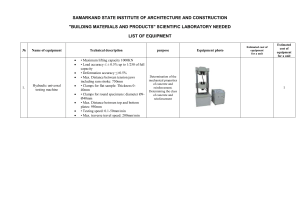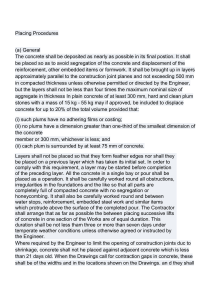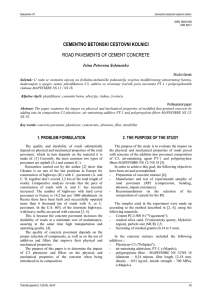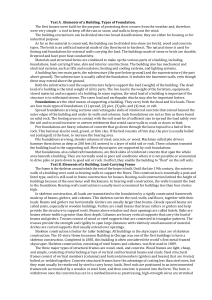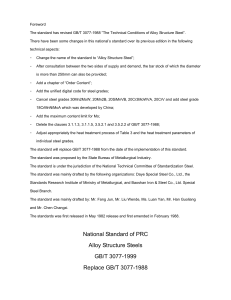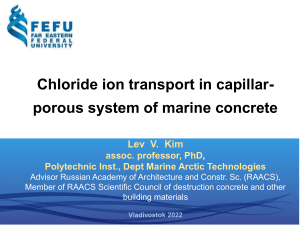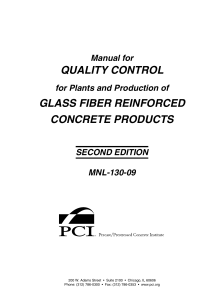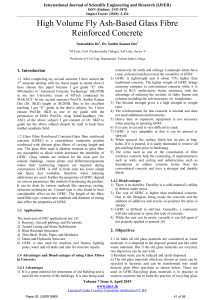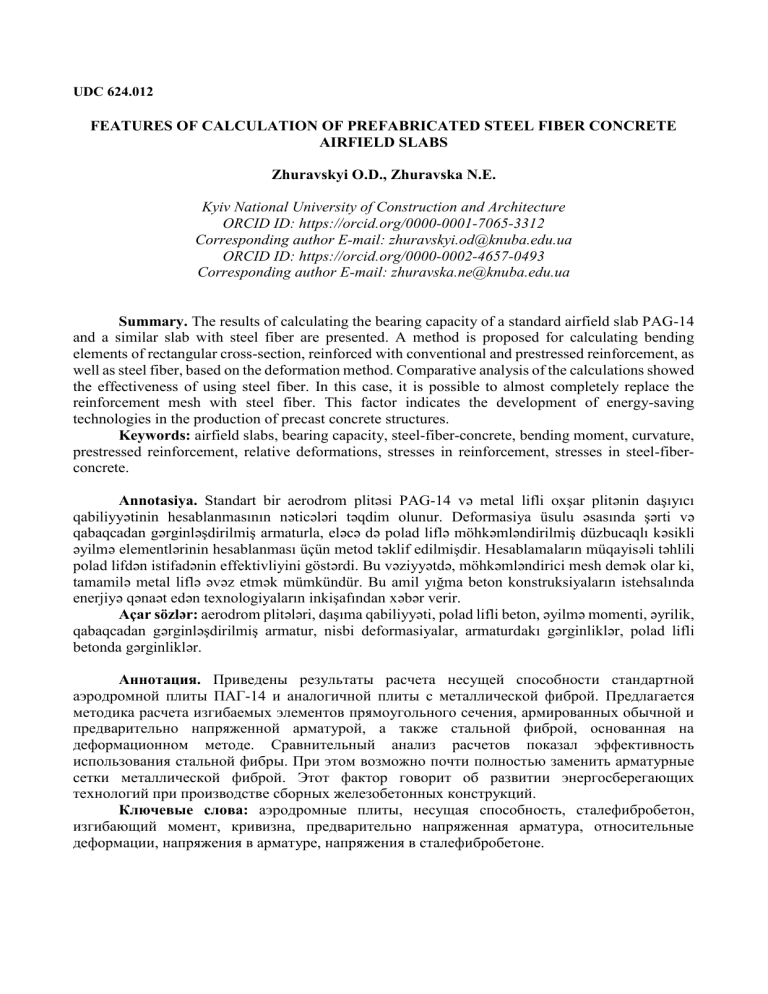
UDC 624.012 FEATURES OF CALCULATION OF PREFABRICATED STEEL FIBER CONCRETE AIRFIELD SLABS Zhuravskyi O.D., Zhuravska N.E. Kyiv National University of Construction and Architecture ORCID ID: https://orcid.org/0000-0001-7065-3312 Corresponding author E-mail: [email protected] ORCID ID: https://orcid.org/0000-0002-4657-0493 Corresponding author E-mail: [email protected] Summary. The results of calculating the bearing capacity of a standard airfield slab PAG-14 and a similar slab with steel fiber are presented. A method is proposed for calculating bending elements of rectangular cross-section, reinforced with conventional and prestressed reinforcement, as well as steel fiber, based on the deformation method. Comparative analysis of the calculations showed the effectiveness of using steel fiber. In this case, it is possible to almost completely replace the reinforcement mesh with steel fiber. This factor indicates the development of energy-saving technologies in the production of precast concrete structures. Keywords: airfield slabs, bearing capacity, steel-fiber-concrete, bending moment, curvature, prestressed reinforcement, relative deformations, stresses in reinforcement, stresses in steel-fiberconcrete. Annotasiya. Standart bir aerodrom plitəsi PAG-14 və metal lifli oxşar plitənin daşıyıcı qabiliyyətinin hesablanmasının nəticələri təqdim olunur. Deformasiya üsulu əsasında şərti və qabaqcadan gərginləşdirilmiş armaturla, eləcə də polad liflə möhkəmləndirilmiş düzbucaqlı kəsikli əyilmə elementlərinin hesablanması üçün metod təklif edilmişdir. Hesablamaların müqayisəli təhlili polad lifdən istifadənin effektivliyini göstərdi. Bu vəziyyətdə, möhkəmləndirici mesh demək olar ki, tamamilə metal liflə əvəz etmək mümkündür. Bu amil yığma beton konstruksiyaların istehsalında enerjiyə qənaət edən texnologiyaların inkişafından xəbər verir. Açar sözlər: aerodrom plitələri, daşıma qabiliyyəti, polad lifli beton, əyilmə momenti, əyrilik, qabaqcadan gərginləşdirilmiş armatur, nisbi deformasiyalar, armaturdakı gərginliklər, polad lifli betonda gərginliklər. Аннотация. Приведены результаты расчета несущей способности стандартной аэродромной плиты ПАГ-14 и аналогичной плиты с металлической фиброй. Предлагается методика расчета изгибаемых элементов прямоугольного сечения, армированных обычной и предварительно напряженной арматурой, а также стальной фиброй, основанная на деформационном методе. Сравнительный анализ расчетов показал эффективность использования стальной фибры. При этом возможно почти полностью заменить арматурные сетки металлической фиброй. Этот фактор говорит об развитии энергосберегающих технологий при производстве сборных железобетонных конструкций. Ключевые слова: аэродромные плиты, несущая способность, сталефибробетон, изгибающий момент, кривизна, предварительно напряженная арматура, относительные деформации, напряжения в арматуре, напряжения в сталефибробетоне. Introduction. In modern construction, steel fiber is added to the concrete to improve the strength and deformability characteristics of concrete [5…8, 14, 16, 17, 19]. This concrete is called steel-fiber-concrete (SFС). Reinforced concrete has increased tensile strength compared to conventional concrete. This makes it possible to take into account the operation of the SFС in the stretched cross-sectional area of the bending elements. Currently, there are no recommendations for the calculation of SFС elements with pre-stressed reinforcement [1…6, 13]. The method of calculation of bending elements of rectangular section, reinforced with ordinary and pre-stressed reinforcement, as well as steel fiber, based on the deformation method is proposed in the work. The purpose of the work is a comparative calculation of typical airfield slabs and slabs with steel fiber. Formulation of the problem. Prefabricated reinforced concrete prestressed slabs PAG-14, which comply with the current DSTU B B.2.6-136: 2010 [4], are used for the arrangement of aerodrome surfaces and helipads. The slabs have dimensions in plan of 6.0×2.0 m and a thickness of 140 mm (Fig. 1). Fig. 1. General view and dimensions of the airfield slab PAG-14 [4] Slabs are made of concrete class C20/25 and reinforced with longitudinal prestressed reinforcement 5Ø14A800 in two levels and reinforcing mesh C2 in two levels with reinforcement Ø5Bp-I with a step of 100 mm, located in the transverse direction of the slab, and 4Ø5Bp-I located in the longitudinal direction of the plate (Fig. 2) [4]. In the end parts there are grids C1 in two levels with reinforcement 4Ø8А400С, located in the transverse direction of the plate, and 2Ø5Вр-І + 2Ø8А400С, located in the longitudinal direction of the plate. Fig. 2. Reinforcement of the airfield slab PAG-14 [4] For alternative airfield plates, the unstressed reinforcement was replaced with STAFIB 50/1.0 steel fiber (ff =1000 MPa; lf =50 mm; df =1 mm; μfv =0,01). Estimated resistance of steel-fiber-concrete to compressive fсf=22,36 MPa and tensile strength fсft=1,49 MPa. The modulus of elasticity of SFC is Есf=24940 MPa. Relative deformations of SFC on compression εсf1=0,00176; εсfu=0,00293. Relative tensile strains SFC εсft1=0,00018; εсftu=0,00035. Method of calculation of combined reinforced bending elements. Consider a bending element of rectangular cross-section, reinforced with steel fiber and rod ordinary and pre-stressed reinforcement in compressed and stretched cross-sectional areas. The stress-strain state of a rectangular combined-reinforced section is shown in Fig. 3 [19]. Fig. 3. Stress-strain state of a rectangular combined-reinforced section [19] Achieving fiber deformations of limit values is accepted as a criterion of exhaustion of bearing capacity on normal section of SFС of an element cftu 2 fcftu / Ecf . The value of the ultimate bending moment for the SFС of bending elements of rectangular cross-section with pre-stressed reinforcement is recommended to be determined by the formulas (Fig. 3) [5, 19]: 𝑏𝑓𝑐𝑓 5 𝑎 3 ∑𝑘=1 𝑘 𝛾 𝑘+1 − 𝑏𝑓𝑐𝑓𝑡 (ℎ − 𝑥1 ) + ∑𝑛𝑖=1 𝜎𝑠𝑖 𝐴𝑠𝑖 = 0; (1) 𝑏𝑓𝑐𝑓 2 ℵ ℵ ∑5𝑘=1 𝑎𝑘 𝑘+2 𝛾 𝑘+1 𝑘+2 4 11 − 24 𝑏𝑓𝑐𝑓𝑡 (ℎ − 𝑥1 )2 + ∑𝑛𝑖=1 𝜎𝑠𝑖 𝐴𝑠𝑖 (𝑥1 − 𝑧𝑠𝑖 ) − 𝑀 = 0. (2) In dependences (1), (2) according to [5]: 1 ℵ= ( r ) - the curvature of the curved axis in cross section (1/m): 𝜀𝑐(1) −𝜀𝑐(2) 1 ℵ = (𝑟 ) = ; ℎ 𝜀𝑐(1) - relative deformations of steel-fiber-concrete in the compressed cross-sectional area; 𝜀𝑐(2) - relative deformations of steel-fiber-concrete in the stretched cross-sectional area; γ - the ratio of relative compression strains εс(1) to the limit εсf1: 𝜀𝑐(1) 𝛾=𝜀 ; 𝑐𝑓1 𝑥1 - the height of the compressed zone (m): 𝜀𝑐(1) 𝑥1 = ℵ ; (4) (5) (6) ℵ - relative curvature: ℵ=𝜀 ℵ 𝑐𝑓1 ; (7) 𝜎𝑠𝑖 - stresses in reinforcing rod; 𝑧𝑠𝑖 - distance from the center of gravity of reinforcement to the extreme verge compressed section; 𝑎𝑘 - the coefficients of the polynomial, which are determined depending on the value of the compressive strength of the SFC according to the method [8]. We present equations (1), (2) in the form [19] 𝑁𝑐𝑓 − 𝑁𝑐𝑓𝑡 + 𝑁𝑠 = 0; (8) 𝑀𝑐𝑓 + 𝑀𝑐𝑓𝑡 + 𝑀𝑠 = 𝑀, (9) where: 𝑁𝑐𝑓 , 𝑀𝑐𝑓 - efforts in the compressed zone of the SFС; 𝑁𝑐𝑓𝑡 , 𝑀𝑐𝑓𝑡 - efforts in the stretched zone of the SFС; 𝑁𝑠 , 𝑀𝑠 - total effort in reinforcing rods. Let's describe the value of internal efforts [19] 𝑏𝑓 𝑎 𝑁𝑐𝑓 = 𝑐𝑓 ∑5𝑘=1 𝑘 𝛾 𝑘+1 ; ℵ (10) 𝑘+1 3 𝑁𝑐𝑓𝑡 = 4 𝑏𝑓𝑐𝑓𝑡 (ℎ − 𝑥1 ); 𝑁𝑠 = 𝜎𝑠2 𝐴𝑠2 + 𝜎𝑠𝑝2 𝐴𝑠𝑝2 − 𝜎𝑠1 𝐴𝑠1 − 𝜎𝑠𝑝1 𝐴𝑠𝑝1 ; 𝑀𝑐𝑓 = 𝑏𝑓𝑐𝑓 2 ℵ 11 ∑5𝑘=1 𝑎𝑘 𝑘+2 𝛾 𝑘+2 ; (13) 𝑀𝑐𝑓𝑡 = 24 𝑏𝑓𝑐𝑓𝑡 (ℎ − 𝑥1 )2 ; 𝑀𝑠 = 𝐴𝑠1 𝐸𝑠1 ℵ(𝑥1 − 𝑧𝑠1 )2 + 𝐴𝑠𝑝1 𝐸𝑠𝑝1 (ℵ(𝑥1 − 𝑧𝑠𝑝1 ) − 𝜀𝑝01 )(𝑥1 − 𝑧𝑠𝑝1 ) + +𝐴𝑠2 𝐸𝑠2 ℵ(𝑥1 − 𝑧𝑠2 )2 + 𝐴𝑠𝑝2 𝐸𝑠𝑝2 (ℵ(𝑥1 − 𝑧𝑠𝑝2 ) − 𝜀𝑝02 )(𝑥1 − 𝑧𝑠𝑝2 ), where: 𝜀𝑝0𝑖 - strain caused by the prestressing reinforcement with all the losses. Tension in normal and prestressing reinforcement: 𝜎𝑠𝑖 = 𝐸𝑠𝑖 ℵ(𝑥1 − 𝑧𝑠𝑖 ); 𝜎𝑠𝑝𝑖 = 𝐸𝑠𝑝𝑖 (ℵ(𝑥1 − 𝑧𝑠𝑝𝑖 ) − 𝜀𝑝0𝑖 ). Substituting expressions (6), (7), (16), (17) in equation (10)…(12), we obtain [19]: 𝑏𝑓 𝜀 𝑎 𝑁𝑐𝑓 = 𝑐𝑓 𝑐𝑓1 ∑5𝑘=1 𝑘 𝛾 𝑘+1 ; 3 ℵ 𝑁𝑐𝑓𝑡 = 4 𝑏𝑓𝑐𝑓𝑡 (ℎ − 𝑘+1 𝜀𝑐𝑓(1) ℵ (11) (12) ); (14) (15) (16) (17) (18) (19) 𝑁𝑠 = 𝐴𝑠2 𝐸𝑠2 ℵ(𝑥1 − 𝑧𝑠2 ) + 𝐴𝑠𝑝2 𝐸𝑠𝑝2 (ℵ(𝑥1 − 𝑧𝑠𝑝2 ) − 𝜀𝑝02 ) − −𝐴𝑠1 𝐸𝑠1 ℵ(𝑥1 − 𝑧𝑠1 ) − 𝐴𝑠𝑝1 𝐸𝑠𝑝1 (ℵ(𝑥1 − 𝑧𝑠𝑝1 ) − 𝜀𝑝01 ); (20) Substituting equation (18)…(20) into (8) and after transformations we obtain the dependence for curvature [19] ℵ= 2 −4𝑎 𝑐 −𝑏∑ +√𝑏∑ ∑ ∑ 2𝑎∑ , (21) 𝑎∑ = 𝐴𝑠1 𝐸𝑠1 𝑧𝑠1 + 𝐴𝑠2 𝐸𝑠2 𝑧𝑠2 + 𝐴𝑠𝑝1 𝐸𝑠𝑝1 𝑧𝑠𝑝1 + 𝐴𝑠𝑝2 𝐸𝑠𝑝2 𝑧𝑠𝑝2; (22) 3 𝑏∑ = 𝑏ℎ𝑓𝑐𝑓𝑡 − 𝜀𝑐𝑓(1) (𝐴𝑠1 𝐸𝑠1 + 𝐴𝑠2 𝐸𝑠2 + 𝐴𝑠𝑝1 𝐸𝑠𝑝1 + 𝐴𝑠𝑝2 𝐸𝑠𝑝2 ) + 4 +𝐴𝑠𝑝1 𝐸𝑠𝑝1 𝜀𝑝01 + 𝐴𝑠𝑝2 𝐸𝑠𝑝2 𝜀𝑝02 ; (23) 3 𝑎 𝑘 𝑐∑ = − 4 𝑏𝑓𝑐𝑓𝑡 𝜀𝑐𝑓(1) − 𝑏𝑓𝑐𝑓 𝜀𝑐𝑓1 ∑5𝑘=1 𝑘+1 𝛾 𝑘+1 . (24) After determining the curvature , its values are substituted into formulas (13)…(15) to determine the moments 𝑀𝑐𝑓 , 𝑀𝑐𝑓𝑡 , 𝑀𝑠 . After that, by formula (9) determine the bending moment M, which corresponds to the curvature ℵ. The calculation is performed step by step for each value of relative deformations in the compressed cross-sectional area 𝜀𝑐(1) , which consistently increases in magnitude 𝛥𝜀𝑐(1) . At each step of the calculation necessary to control the tension in the prestressed reinforcement, which is located in a stretched zone section. To do this, use the diagram "σ-ε" for stressed steel (Fig. 4) [1]. Upon reaching the stress values 𝜎𝑠𝑝 ≥ 𝑓𝑝𝑑 in the following steps, the stress in the prestressed reinforcement must be determined by the formula [9] where: 𝑓 𝜀𝑠𝑝 −𝜀𝑝0 𝜎𝑠𝑝 = 𝑓𝑝𝑑 + ( 𝛾𝑝𝑘 − 𝑓𝑝𝑑 ) 𝜀 𝑠 where: 𝑓𝑝𝑑 = 𝑓𝑝0,1𝑘 𝛾𝑠 ; 𝜀𝑝0 = 𝑓𝑝𝑑 𝐸𝑝 ; 𝑢𝑑 −𝜀𝑝0 , 𝜀𝑢𝑑 = 0,9𝜀𝑢𝑘 ; 𝜀𝑠𝑝 = ℵ(𝑥1 − 𝑧𝑠𝑝 ) − 0,0021. (25) Fig. 4. Idealized and calculated diagram "σ-ε" for stressed steel [1] To determine the bearing capacity of SFС with pre-stressed reinforcement developed an algorithm, which is implemented in the program Mathcad. Comparative calculation of prestressed airfield slab. As a result of comparative calculation, it was found that the bearing capacity of the PAG-14SFC plate, in which the reinforcing mesh was replaced by steel fiber, was Mu = 86.73 kNm (Fig. 5). The bearing capacity of the standard plate PAG-14 was Mu = 71.49 kNm, which is less by 21.3 %. The efficiency of the plate with steel fiber is that the steel fiber almost completely replaces the reinforcing mesh with a total weight of 72.0 kg. There are also no costs for the manufacture of these grids. Comparative calculation showed that it is possible to reduce the number of high-strength prestressed reinforcement to 10…15 %. Fig. 5. Graphs "momentcurvature" when calculating the plate PAG-14-SFС with metal fiber and standard plate PAG-14 The scientific developments of the authors of the article are related to their previous research, which is presented in [10, 12, 15]. Conclusions The general algorithm of calculation of bending elements of rectangular section reinforced by usual and prestressed reinforcing rod, and also steel fiber is offered. The calculation method is based on the deformation theory of calculation of reinforced concrete structures taking into account the complete diagram "σ-ε" for concrete and reinforced concrete for compression. As a result of comparative calculation of the bearing capacity of the standard aerodrome plate PAG-14 and a similar plate with metal fiber, it was found that the bearing capacity of the plate with steel fiber is higher than the standard by 21.3 %. The efficiency of steel fiber boards is that the steel fiber allows you to completely replace the structural reinforcement. Due to the good anti-abrasion properties of steel-fiber-concrete, their service life is much longer than reinforced concrete. These factors indicate the development of energy-saving technologies in the production of precast concrete structures [20…22]. REFERENCES 1. 2. 3. 4. 5. 6. 7. 8. DBN V.2.6-98:2009. Konstruktsii budynkiv i sporud. Betonni ta zalizobetonni konstruktsii. Osnovni polozhennia. (DBN B.2.6-98: 2009. Constructions of houses and buildings. Concrete and reinforced concrete structures. Substantive provisions) – K.: Minrehionbud Ukrainy, 2009. -71 s. DSTU B V.2.6.-156:2010. Konstruktsii budynkiv i sporud. Betonni ta zalizobetonni konstruktsii z vazhkoho betonu. Pravyla proektuvannia. (DSTU B B.2.6.-156: 2010. Constructions of houses and buildings. Concrete and reinforced concrete structures made of heavy concrete. Design rules) –K.: Minrehionbud Ukrainy, 2011. -118 s. DSTU-N EN 1992-1-1:2010. Budivelni materialy i konstruktsii. Proektuvannia zalizobetonnykh konstruktsii. Osnovni polozhennia. Zahalni pravyla proektuvannia (EN 1992-1-1:2004, IDT). (DSTU-N EN 1992-1-1: 2010. Building materials and structures. Design of reinforced concrete structures. Substantive provisions. General design rules (EN 1992-1-1:2004, ІDТ)) – Kyiv: Minrehionbud Ukrainy, 2010. – S.341. DSTU B B.2.6-136:2010. Konstruktsii budynkiv i sporud. Plyty zalizobetonni poperedno napruzheni PAG-14 dlia aerodromnoho pokryttia. (DSTU B B.2.6-136:2010. Constructions of houses and buildings. Reinforced concrete slabs prestressed PAG-14 for airfield coverage). – Kyiv: Minrehionbud Ukrainy, 2011. – S.15. DSTU-N B V.2.6-218:2016. Nastanova z proektuvannia ta vyhotovlennia konstruktsii z dyspernoarmovanoho betonu. (DSTU-N B B.2.6-218: 2016. Guidelines for the design and manufacture of structures of dispersed reinforced concrete) – Kyiv: DP «UkrNDNTs», 2017. – S. 32. DSTU-N B V.2.6-78:2009. Konstruktsii budynkiv i sporud. Nastanova z proektuvannia ta vyhotovlennia stalefibrobetonnykh konstruktsii. (DSTU-N B V.2.6-78:2009. Constructions of houses and buildings. Guidelines for the design and manufacture of reinforced concrete structures). –K.: Minrehionbud Ukrainy, 2009. -43 s. Horobets A.M. Doslidzhennia vtrat poperednoho napruzhennia v stalefibrobetonnykh plytakh pry odnoosnomu ta dvokhosnomu obtysku (Investigation of prestress losses in SFC plates with uniaxial and biaxial compression) / Horobets A.M., Zhuravskyi O.D. // Resursoekonomni materialy, konstruktsii, budivli ta sporudy: Zbirnyk naukovykh prats. Vyp. 16, chastyna 2. Rivne, 2008, S. 123-128. Horobets A.M. Mitsnist ta trishchynostiikist dvokhosno poperedno-napruzhenykh stalefibrobetonnykh plyt pry poperechnomu zghyni (Strength and crack resistance of biaxially 9. 10. 11. 12. 13. 14. 15. 16. 17. 18. 19. 20. 21. 22. prestressed SFC plates at transverse bending) / Horobets A.M., Zhuravskyi O.D. // Budivelni konstruktsii. Teoriia i praktyka: Zbirnyk naukovykh prats. – K., KNUBA, -Vyp. 1., 2017, S. 181186. Proektuvannia zalizobetonnyz konstruktsii. Posibnyk (Design of reinforced concrete structures. Manual) / A.M.Bambura, HR.Sazonova, O.V. Dorohova, O.V.Voitsekhivskyi / Za red. A.M. Bambura. Kyiv: Maister knyh, 2018. 240 s. Panchenko О.V., Ivanytskyi Ya.L., Kun P.S., Zhuravskyi О.D. (2017) Determination of the Durability of Ferroconcrete Bridge Beams Reinforced by Composite Strips // Materials Science. March 2018, Volume 53, Issue 5, pp 660–665. https://doi.org/10.1007/s11003-018-0121-3. EN 1992-1-1. Eurocode 2: Design of Concrete Structures. Part 1-1: General Rules and Rules for Buildings. [Final Draft, December, 2004]. Brussels: CEN. 2004. 225 p. Kozak O., Zhuravskyi O., Delyavskyy M. Effect of the pre-stressed reinforcement curvature on the bearing capacity of inclined sections of monolithic beams. Cite as: AIP Conference Proceedings 2077, 020027 (2019); https://doi.org/10.1063/1.5091888. Published Online: 21 February 2019. RILEM TC 162-TDF. Design of steel fibre reinforced concrete using the σ-w method – principles and applications. Materials and Structures. 2002. Vol. 35. P. 262–278. https://doi.org/10.1007/BF02482132. Zhuravskyi O. Experimental and theoretical studies of biaxially prestressed steel-fiber-concrete slabs / O.Zhuravskyi, A.Gorobetc // USEFUL online journal, vol. 2, no. 3, pp. 10–14, Oct. 2018. DOI: https://doi.org/10.32557/useful-2-3-2018-0003. Zhuravskyi O. Calculation of flat reinforced concrete slabs strengthened by post-stressed rebars in two directions / O.Zhuravskyi, V.Tymoschuk // USEFUL online journal, vol. 2, no. 4, pp. 63– 69, Oct. 2018. DOI: https://doi.org/10.32557/useful-2-4-2018-0007. Smorkalov D., Zhuravskyi O., Delyavskyy M. Experimental and theoretical studies of single and double-layer slabs supported on four sides. Cite as: AIP Conference Proceedings 2077, 020052 (2019); https://doi.org/10.1063/1.5091913. Published Online: 21 February 2019. Zhuravskyi O.D. Bearing capacity of steel-fiber-concrete slabs with biaxially prestressed reinforcement // Strength of Materials and Theory of Structures: Scientific-and-technical collected articles. – K.: KNUBA, 2020. – Issue 105. – P. 292-301. DOI: 10.32347/24102547.2020.105.292-301. Zhuravskyi, O., Tymoshchuk, V., Zhuravska, N., Hajiyev, M. Influence of Strengthening Flat Slab by External Prestressed Reinforcement on Deformation Characteristics of the Slab. Lecture Notes in Civil Engineering this link is disabled, 2022, 181, -P. 449–456. Springer, Cham. https://doi.org/10.1007/978-3-030-85043-2_42. Zhuravskyi O. (2020). Method and example of calculation of combined reinforced bending elements. Academic journal. Series: Industrial Machine Building, Civil Engineering, 1(54), 4046. https://doi.org/10.26906/znp.2020.54.2268. Kulikov, P., Bondar, O., Zhuravska, N. Environmental management of production processes in heating systems when receiving magnetic water in reagent free method with the aim of environmentalization. International Journal of Engineering and Technology (UAE) this link is disabled, 2018, 7(3), стр. 621–625. DOI: 10.14419/ijet.v7i4.8.27284. Zhuravska, N., Malkin, E., Sobczak-Piastka, J. Energy Efficient Processing of Geotermal Water for Energy-Heating Objects of the Building Industry. IOP Conference Series: Earth and Environmental Science this link is disabled, 2019, 362(1), 012116. DOI:10.1088/17551315/362/1/012116. Dinzhos, R., Fialko, N., Prokopov, V., ... Parkhomenko, O., Zhuravskaya, N. Identifying the influence of the polymer matrix type on the structure formation of microcomposites when they are filled with copper particles. Eastern-European Journal of Enterprise Technologies this link is disabled, 2020, 5(6-107), Р. 49–57. DOI:10.15587/1729-4061.2020.214810.
